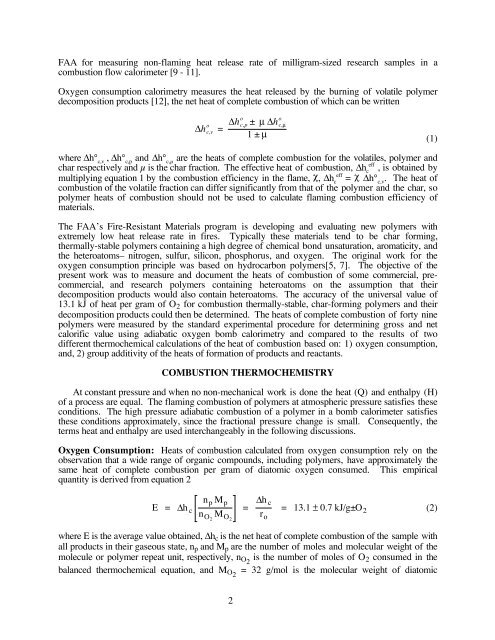HEATS OF COMBUSTION OF HIGH TEMPERATURE POLYMERS
HEATS OF COMBUSTION OF HIGH TEMPERATURE POLYMERS
HEATS OF COMBUSTION OF HIGH TEMPERATURE POLYMERS
You also want an ePaper? Increase the reach of your titles
YUMPU automatically turns print PDFs into web optimized ePapers that Google loves.
FAA for measuring non-flaming heat release rate of milligram-sized research samples in a<br />
combustion flow calorimeter [9 - 11].<br />
Oxygen consumption calorimetry measures the heat released by the burning of volatile polymer<br />
decomposition products [12], the net heat of complete combustion of which can be written<br />
o o<br />
o ∆hc,p ± µ∆hc,µ<br />
∆hc,v =<br />
1±µ<br />
where ∆h° c,v , ∆h° c,p and ∆h° c,µ are the heats of complete combustion for the volatiles, polymer and<br />
eff<br />
char respectively and µ is the char fraction. The effective heat of combustion, ∆hc , is obtained by<br />
multiplying equation 1 by the combustion efficiency in the flame, χ,<br />
eff<br />
∆hc = χ ∆h° c,v . The heat of<br />
combustion of the volatile fraction can differ significantly from that of the polymer and the char, so<br />
polymer heats of combustion should not be used to calculate flaming combustion efficiency of<br />
materials.<br />
The FAA’s Fire-Resistant Materials program is developing and evaluating new polymers with<br />
extremely low heat release rate in fires. Typically these materials tend to be char forming,<br />
thermally-stable polymers containing a high degree of chemical bond unsaturation, aromaticity, and<br />
the heteroatoms– nitrogen, sulfur, silicon, phosphorus, and oxygen. The original work for the<br />
oxygen consumption principle was based on hydrocarbon polymers[5, 7]. The objective of the<br />
present work was to measure and document the heats of combustion of some commercial, precommercial,<br />
and research polymers containing heteroatoms on the assumption that their<br />
decomposition products would also contain heteroatoms. The accuracy of the universal value of<br />
13.1 kJ of heat per gram of O2 for combustion thermally-stable, char-forming polymers and their<br />
decomposition products could then be determined. The heats of complete combustion of forty nine<br />
polymers were measured by the standard experimental procedure for determining gross and net<br />
calorific value using adiabatic oxygen bomb calorimetry and compared to the results of two<br />
different thermochemical calculations of the heat of combustion based on: 1) oxygen consumption,<br />
and, 2) group additivity of the heats of formation of products and reactants.<br />
<strong>COMBUSTION</strong> THERMOCHEMISTRY<br />
At constant pressure and when no non-mechanical work is done the heat (Q) and enthalpy (H)<br />
of a process are equal. The flaming combustion of polymers at atmospheric pressure satisfies these<br />
conditions. The high pressure adiabatic combustion of a polymer in a bomb calorimeter satisfies<br />
these conditions approximately, since the fractional pressure change is small. Consequently, the<br />
terms heat and enthalpy are used interchangeably in the following discussions.<br />
Oxygen Consumption: Heats of combustion calculated from oxygen consumption rely on the<br />
observation that a wide range of organic compounds, including polymers, have approximately the<br />
same heat of complete combustion per gram of diatomic oxygen consumed. This empirical<br />
quantity is derived from equation 2<br />
E = ∆h c<br />
n p M p<br />
n O2 M O2<br />
2<br />
= ∆h c<br />
r o<br />
= 13.1 ± 0.7 kJ/g±O 2<br />
where E is the average value obtained, ∆hc is the net heat of complete combustion of the sample with<br />
all products in their gaseous state, np and Mp are the number of moles and molecular weight of the<br />
molecule or polymer repeat unit, respectively, nO 2 is the number of moles of O2 consumed in the<br />
balanced thermochemical equation, and MO 2 = 32 g/mol is the molecular weight of diatomic<br />
(1)<br />
(2)
















